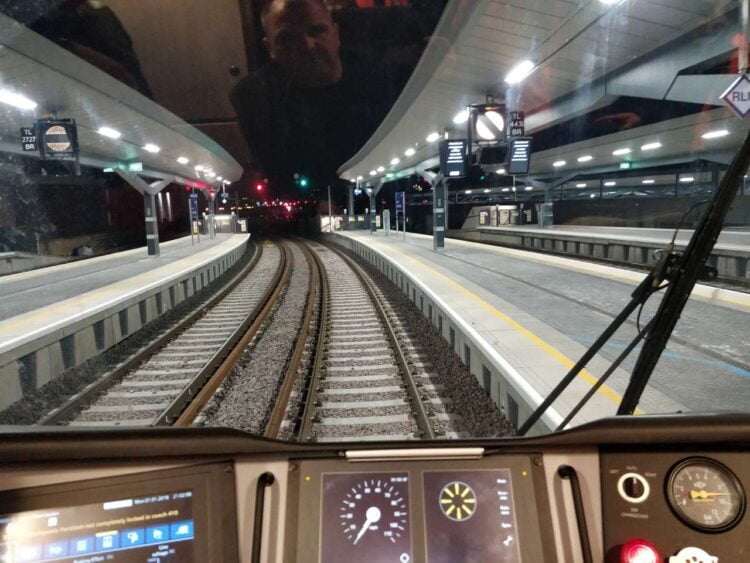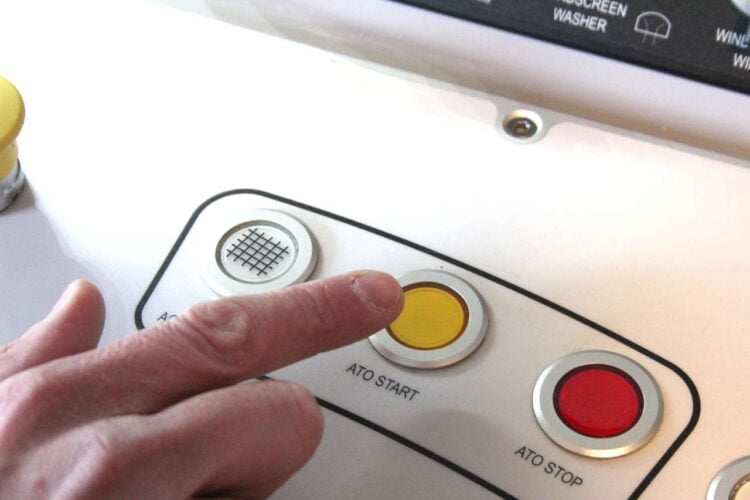Thameslink driver Clint Almeida has made the hundred thousandth digitally-signalled journey between St Pancras and London Bridge.
The journey was also the eighty thousandth self-drive trip made by Thameslink in a Siemens-built Desiro City train since digital in-cab signalling and self-drive ‘automatic train operation’ was introduced in 2016.
Thameslink is so far the only mainline UK rail route to use the digital-signalling system. There are plans to extend digital signalling to other routes, but the self-drive element is not part of these plans as it is only required on the high-frequency, central London section of the Thameslink route.

Currently, just over a third of all journeys between St Pancras and London Bridge run using the digital ‘European Train Control System’ (ETCS), this number is increasing as more drivers receive training to use the system. Digital signalling enables train to run much closer to one another, which allows a more frequent reliable service.
Digital signalling replaces signals at the side of the track. Instead, drivers follow a target speed set by the system in their cab, which uses information relayed from beacons along the track to identify the location of other trains. This allows drivers to ‘see’ what’s ahead up to 2km away.
Trains converge on Thameslink’s busy central London section from stations including as Peterborough, Bedford, Cambridge, Brighton, Rainham, Sutton and Sevenoaks. Digital signalling helps prevent delays in the middle of the network which would have a knock-on effect elsewhere.
Under self-drive automatic train operation, the system takes control of the train, braking and accelerating in accordance with the target speed and bringing the train to a halt in the next station and opening the doors. The driver checks that the platform is clear, closes the doors and selects ATO again, and retains control of the overall safe operation of the train.

Clint Almeida, a 40-year-old father-of-three from Croydon, was in the cab of the 08:48 service from Bedford to Brighton on Friday 13 October, and was being assessed in using the technology at the end of a five-day course. The training was delivered by Mark Webb, one of Thameslink’s in-house team of Testing and Commissioning drivers. Clint switched to digital signalling on the approach to St Pancras, and selected self-drive ATO for the journey to London Bridge. He passed his assessment.
Clint said:“It’s much better, I can see why it’s termed ‘the railway of the future’. Digital ETCS shows me what’s up ahead up to about 2,000m away in central London and that’s safer. I know it’s going to be clear coming into the station and that helps us a lot.
“It takes a lot of getting used to, not looking at signals on the trackside and taking instructions from within the cab, but it’s good.
“Self-drive ATO takes digital ETCS to the next level and pretty much drives the train to its limit with faster acceleration and braking. We all drive differently so this makes it consistent and I’m there to manage the overall safe operation of the train.”
Grace Roche, ERTMS Thameslink Operations Manager at Govia Thameslink Railway, said: “Reaching the 100,000thjourney in ETCS is a significant milestone and demonstrates we are moving towards digital signalling becoming our standard method of operation on this critical part of the network – and that we’re striving to deliver the most reliable service possible for our customers.
“As the biggest ETCS operation in the UK, there is a lot we can learn from our experience here. We are working closely with our colleagues at Network Rail to ensure that lessons learned are being applied to the introduction of ETCS on the Northern City Line, as part of the East Coast Digital Programme, where digitally signalled operations are expected to commence later this year.
“I’d like to thank everyone involved in getting us to this key milestone.”
Mark Merrydew, GTR’s Testing & Commissioning Driver Manager said: “My team of testing and commissioning drivers have been instrumental in helping our driver colleagues get to grips with ETCS, sharing their knowledge and experience of the system. We’ve come a long way since first introducing ETCS back in 2016 and the 100,000th digitally signalled train is a significant milestone to reach! We’re looking forward to seeing that number increase as we support more drivers to become competent in the system.”
Kevin Clark, Fleet Operations Director at Siemens Mobility, said: “It is fantastic that so many passenger journeys have been improved by this technology on our trains. The ‘core’ section of the Thameslink network is very demanding with the slightest delay having the potential to cause further delays to following trains.
“We have worked with GTR and Network Rail in fitting the ETCS signalling system which provides continuous, real-time information to the driver’s cab and allows all trains to run safely and efficiently with an optimised headway and speed profile, smoothing the flow of trains and resulting in a more reliable service for passengers.”
“We’re proud to have delivered the trains and signalling systems that have transformed rail travel for millions of Londoners.”
Ed Akers, Network Rail’s Principal Programme Sponsor for the East Coast Digital Programme (ECDP) said: “This milestone shows the experience now accumulated in the use of digital signalling. We continue to build on that knowledge as the Desiro City fleet involved is put through an upgrade to the latest version of the ETCS. That fleet, and others, will in future be making millions of digitally signalled journeys through the ECDP – Britain’s first deployment of ETCS on an intercity mainline.”






Responses
Now do something about the park bench seats